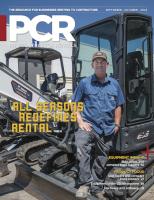Cummins 4-cylinder engines -- smaller meets stronger
Just as one size engine doesn’t fit the equipment or duty cycles of every piece of compact equipment, neither does a single approach to meeting Tier 4 Final emissions regulations.
 Cummins took the cumulative experience gained from building ultra-reliable engines such as the larger Cummins QSB6.7 and incorporated that technology into all three of its 4-cylinder compact platforms for Tier 4 Final/Stage IV. The QSF2.8, QSF3.8, and QSB4.5 are designed to deliver a small footprint, simplified installation, strong performance, exceptional efficiency and ease of use. Every engine has been subjected to extreme testing for reliability and durability and is backed by Cummins parts, service and support. It’s an approach that standardizes and maximizes common features where it makes the most sense and optimizes technology to deliver the best results.
Cummins took the cumulative experience gained from building ultra-reliable engines such as the larger Cummins QSB6.7 and incorporated that technology into all three of its 4-cylinder compact platforms for Tier 4 Final/Stage IV. The QSF2.8, QSF3.8, and QSB4.5 are designed to deliver a small footprint, simplified installation, strong performance, exceptional efficiency and ease of use. Every engine has been subjected to extreme testing for reliability and durability and is backed by Cummins parts, service and support. It’s an approach that standardizes and maximizes common features where it makes the most sense and optimizes technology to deliver the best results.
The 4-cylinder QSF2.8, with 49- to 74-hp (37-55 kW) output, is the smallest-ever Cummins engine to be introduced with full-authority electronic management and a High Pressure Common Rail (HPCR) fuel system. Small in size and light in weight due to the innovative use of composite materials, the QSF2.8 is ideally suited for highly compact equipment such as skid steer loaders and mini-excavators.
The Cummins Compact Catalyst (CCC) aftertreatment with a "fit-and-forget" advantage offers easier installation for Tier 4 Final/Stage IV. The QSF2.8 has an installation envelope comparable in size and weight to engines smaller than 2.8-liter displacement, but combines this with the durability expected from an engine with a larger displacement. The QSF2.8 is built with exceptional strength at the heart of the engine, capable of the same peak cylinder pressure as Cummins proven QSB4.5.
Although the architecture of the QSF2.8 has many aspects in common with that of a higher displacement engine, the weight of the 2.8-liter is remarkably low at just 507 pounds (230 kg) due to the sculpted design of the high-strength cast-iron block and innovative use of composite material for features such as the valve cover. The QSF2.8 also takes a design lead from the Cummins QSB4.5 engine by incorporating a rear gear train, providing superior mounting stiffness and lower gear noise.
The QSF3.8 engine, with power output from 85- to 132-hp (63-98 kW), is ready to meet U.S. Environmental Protection Agency (EPA) Tier 4 Final and European Union (EU) Stage IV near-zero emissions standards. The all-new 4-cylinder, 3.8-liter platform, with full-authority electronic controls and High Pressure Common Rail (HPCR) fuel system, is designed as a fully integrated air-intake-to-exhaust aftertreatment system supplied as a drop-in installation for all types of compact construction and materials-handling equipment.
The QSF3.8 utilizes cooled Exhaust Gas Recirculation (EGR) and the latest Selective Catalytic Reduction (SCR) technology from Cummins Emission Solutions without the need for a Diesel Particulate Filter (DPF). With the advantage of a clean-sheet design, the QSF3.8 is able to combine the performance attributes of a compact, highly-economic engine with the proven durability associated with Cummins larger QSB4.5 engine.
The QSF3.8 will continue the reputation established by the popular Cummins QSB3.3 at Tier 4 Interim/Stage IIIB. Although larger in displacement and meeting more severe emissions standards, the QSF3.8 achieves fuel efficiency similar to that of the 3.3-liter engine. The 132-hp (98 kW) maximum power of the QSF3.8 exceeds that of the QSB3.3 to reach the highest output in the sub-4-liter engine class. The QSF3.8 peak torque is equally impressive, at 360 lb-ft (488 N•m).
The next-generation QSB4.5 engine will meet Tier 4 Final near-zero emissions standards with top-rated power increased to 173-hp (129 kW) and a higher peak torque of 520 lb-ft (705 N•m). The 4-cylinder, 4.5-liter engine is performance-enhanced with a Cummins VGT™ Variable Geometry Turbocharger, enabling the higher ratings of the QSB4.5 to reach performance levels previously associated with larger 6-cylinder engines.
For the QSB4.5 lower ratings – down to 121-hp (90 kW) – the VGT technology improves transient response on a fuel-efficient basis. For equipment operation, this means a stronger, faster response to increasing load demands compared with Tier 4 Interim engines. Deep structural strength equips the engine to handle high load factors with relaxed operation, while features such as a rear gear train provide superior stiffness and lower gear noise.
The High Pressure Common Rail (HPCR) fuel system and Electronic Control Module (ECM) of the 4-cylinder QSB4.5 are of the same design, and offer robustness equal to that of the fuel system and ECM utilized on the 6-cylinder QSB6.7, capable of up to 300-hp (224 kW). The QSB4.5 meets near-zero Tier 4 Final emissions standards using a Diesel Oxidation Catalyst (DOC) and Selective Catalytic Reduction (SCR), supplied by Cummins Emission Solutions.









